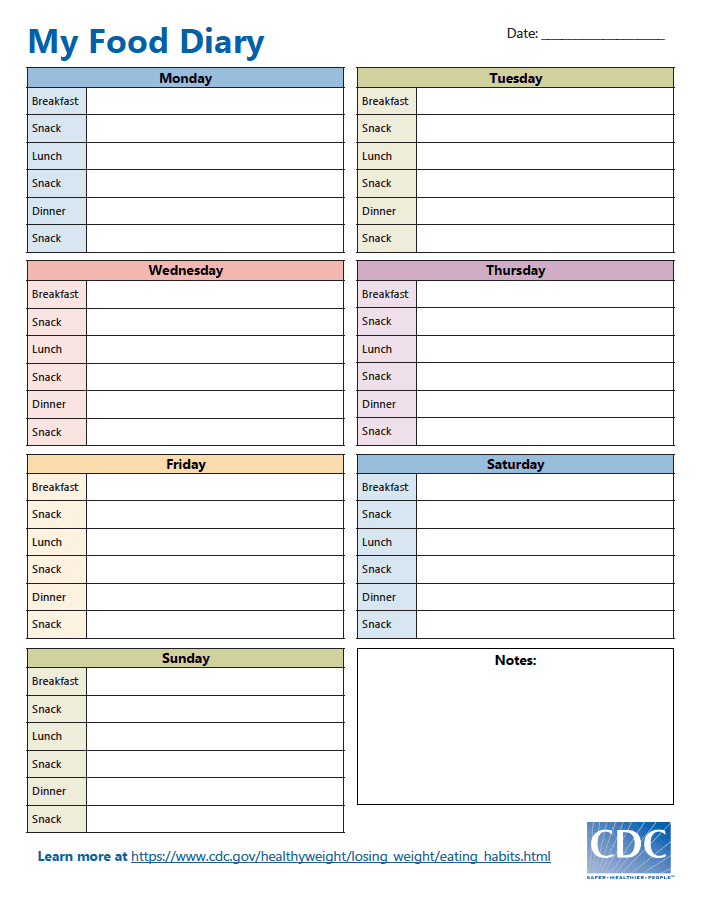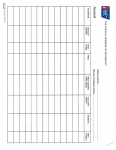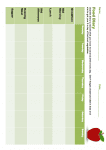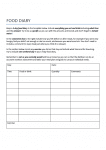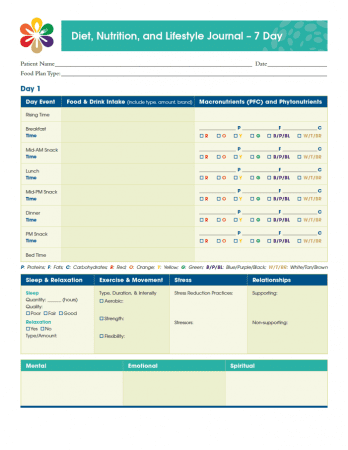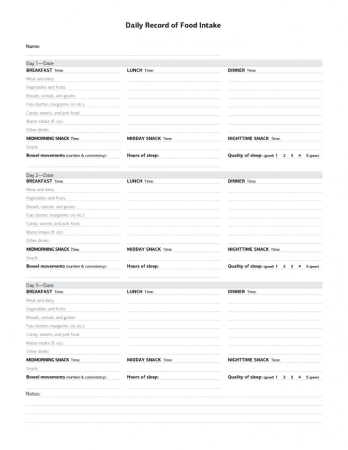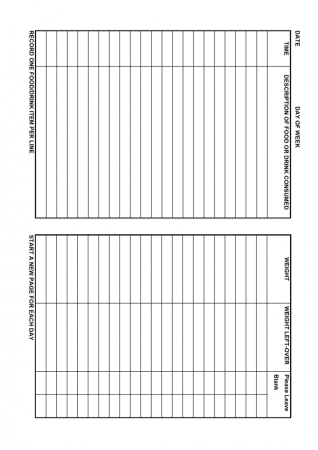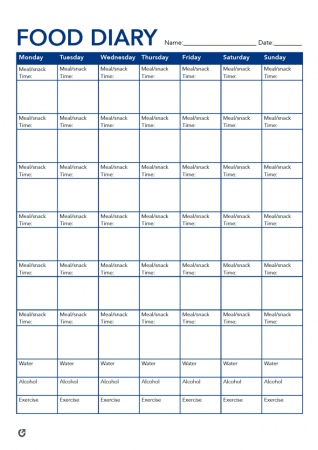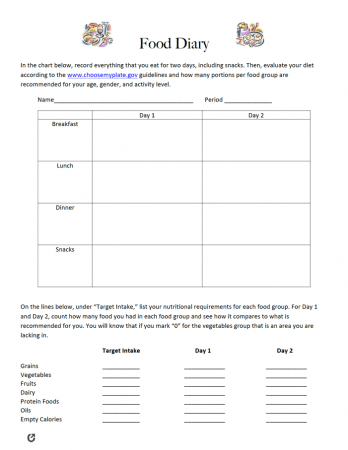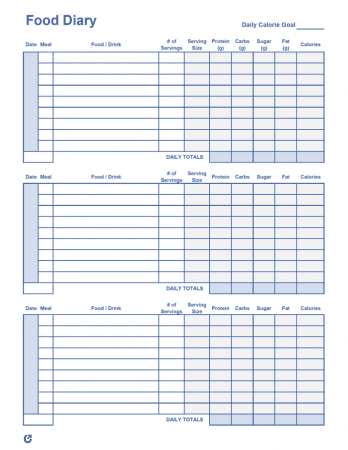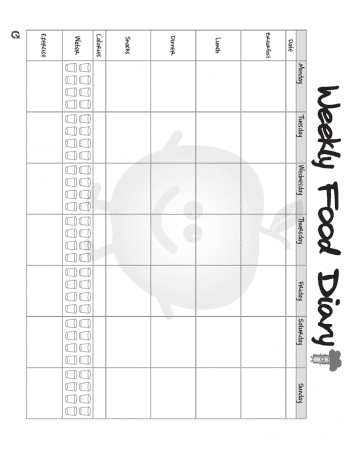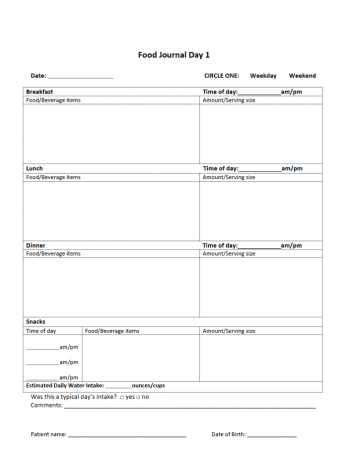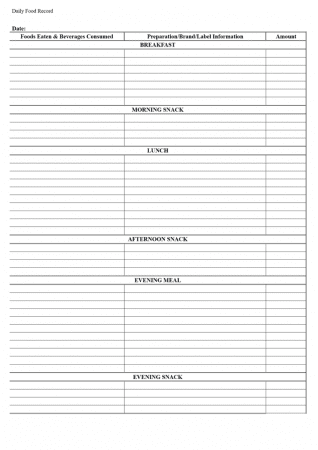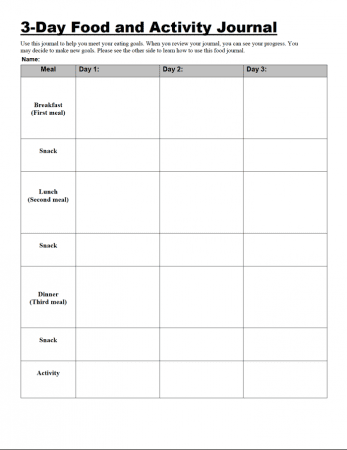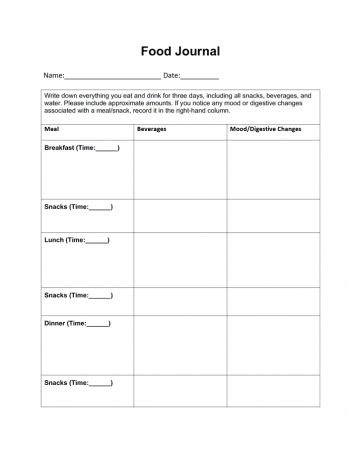Food Diary Templates
A food diary template assists an individual in tracking their meal choices when dieting or following a specific food plan. It provides ongoing data on eating patterns so that the user can maintain their choices the same or change them to better suit their goals. A person can download the template to fill it out electronically, or they can print it and write the details by hand. Each chart uses a specific format, however, they commonly include sections for breakfast, lunch, dinner, snacks, and dessert. Individuals can enter what they had for the meals, along with calories, nutrients, or macronutrients.
Table of Contents |
Printable Food Diary Templates
Benefits of a Food Diary Template
Individuals use food diary templates for many reasons. Primarily, they are helpful when following a specific diet or bringing awareness to food choices. Consistency is vital when tracking foods, as you need plenty of data to find patterns or trends.
Food diary templates allow for customization and personalization to fit your needs. In addition to tracking food choices, you can also monitor your other habits, such as hydration, exercise, or other self-care routines. Using this information, you can identify the practices that work best for your mental and physical health.
Monitor Intake
Food diary templates make it easier to track your food and beverage intake. You can use the information to find trends and patterns between your eating habits and how you feel mentally or physically. For instance, you could find that you eat more when feeling tired or eat less on exercise days. This information can be beneficial when dieting or determining food allergies.
Balance in Healthy Habits
Other healthy routines tend to follow when you incorporate one healthy habit into your life. Suppose you become consistent in monitoring your food choices. As a result, you may feel motivated to track your exercise throughout the week. Furthermore, certain food logs include columns for other information, such as hydration, meditation, yoga, or exercise tracking.
Tracking your foods can also promote balanced eating. You may find patterns in your eating habits, such as overeating on the weekends. Using a chart, you can note these trends and change your routine to add healthier items into your routine. Similarly, you can incorporate a meal planning chart into your food diary to know the foods you will eat for the week ahead.
Provides Guidance
A diary outlines your eating habits, such as the food amount and types, allowing you to use the details to maintain or change your eating habits. For example, you may find that certain foods do not make you feel good, whereas others make you feel great. You can, therefore, use this information to create a meal plan with your “feel good” foods.
Accountability
Maintaining a food template gives you a way to write down your foods as you eat throughout the day. People often keep the chart in an accessible area to ensure they keep up with it. Similarly, they could set alarms or have someone remind them to write down their meals. Furthermore, individuals tracking their food choices can set goals and rewards to ensure they stick with tracking.
7 Day Food Diary PDF
How to Keep a Food Diary for IntoleranceIf you suffer from food intolerances but do not know which foods are the culprit, you may benefit from using a diary. A food diary template allows you to write down the food you eat and the bodily symptoms you experience throughout the day. Unlike an allergy, an intolerance is when your body has an adverse chemical reaction to a drink or food item. As a result, you may experience digestional issues, such as bloating, pain, or nausea. After using a template for a set period, you may start to notice patterns with your intake and symptoms, which can help you determine foods or drinks to avoid in the future. |
Types of Food Diary Templates
Food journaling helps people track their choices for various reasons. Individuals that suffer from food allergies, intolerances, or other health-related conditions seek comfort in having access to their food choices. Others prefer to monitor their intake to achieve weight loss goals or improve mental health.
Anyone can use a food diary template, although the individuals listed below may find additional benefits in using one.
Medical
- Diabetes: Individuals who have Type I or Type II diabetes often track their food choices throughout the day, along with their blood sugar and insulin intake. Therefore, they may find a food diary template, blood sugar chart, or medication schedule template exceptionally helpful.
- Gastrointestinal: People suffering from digestional issues, such as irritable bowel syndrome, diverticulitis, or Crohn’s disease, generally follow a strict meal plan. A food diary template can help them discover the foods that positively or negatively impact their symptoms. In addition, they can observe how hydration, exercise, or stress-relieving activities affect how they feel.
- Gastroesophageal Reflux Disease (GERD): Many people experience GERD – a condition that causes severe acid reflux. Individuals wanting to decrease their symptoms can use a template to narrow down the foods or routines that contribute to their symptoms.
Dietary
- Diets: Individuals following a specific diet need to eat particular foods. Using a food diary template can help them record their favorite recipes or ingredients to keep up with the plan. Examples of diets include the ketogenic diet, paleolithic diet, Mediterranean diet, or the Atkins diet. A doctor could recommend the diet for a health reason, although people can follow them for personal reasons.
- Finding Triggers: People experiencing negative symptoms after eating benefit from a food diary as it can help them pinpoint the triggering foods. Doctors often recommend elimination diets to find food allergies or intolerances. Individuals should consult their doctor before following an elimination diet since severe food allergies are life-threatening.
- Pregnancy: Pregnant women may want to change their eating habits to impact the baby’s development positively. Completing a log can help women eliminate certain foods or add other items into their daily eating routine. However, pregnant women should always consult their doctor before changing their eating routine.
Weight
- Eating Disorders: Individuals working with their doctor to overcome an eating disorder may benefit from using a food diary template. For example, they can record their choices to reach specific goals set with their physician. (Disclaimer: If you are suffering from an eating disorder of any kind, consult with your primary care physician or counselor before using this template.)
- Weight Loss: A food log can help you record your eating patterns to calculate calories or macronutrients when losing weight. Using a food diary template is commonly the first step to creating a meal plan. Therefore, it can help you learn more about your choices and change them if needed.
Food Diary Templates Word
How to Keep a Food Diary
Follow the steps below to create a food diary template and stick to a set routine for monitoring.
- Step One – Determine Frequency
- Step Two – Download or Print
- Step Three – Track Information
- Step Four – Monitor Data
Step One – Determine Frequency
Determine how often you want to log your meals, along with the information that you want to track. For example, you can track your sleep times along with your food choices. Similarly, you can decide to log just one meal, such as your lunches, or log each individual meal throughout the day. You can also log your meals for three days at a time, for a week, or a month. By choosing a realistic template, you can add the amount of detail that feels best for you.
Step Two – Download or Print
Consider what you are looking for in a template before downloading or printing. For example, individuals tracking their calories would choose a different chart from someone monitoring their macronutrients.
Step Three – Track Information
Follow the directions for the template provided in the PDF, Word, or Excel file. It may help to think about how often you want to track and your routine for writing down the items. Having an action plan can help you stick with it. People can use phone notifications or sticky notes to remind them to track, or they may put the template in a visible place. They may also ask their family members or friends to check in with them as a reminder frequently.
Step Four – Monitor Data
After you’ve been tracking for an extended period, you may notice shifts in your weight, mood, or how you feel physically. Writing this information down can help you form an ideal eating plan. Similarly, you can bring the completed chart to your doctor or a nutritionist for their observation.
How to Keep a Food Diary for AllergiesTracking your intake using a food diary can help you discover food allergies. You can monitor the foods you are eating along with your body’s reaction or symptoms. Food allergies are different from intolerances because they are potentially life-threatening. Therefore, you must consult with your doctor before using a food chart for this purpose. |
3 Day Food Diary Templates
